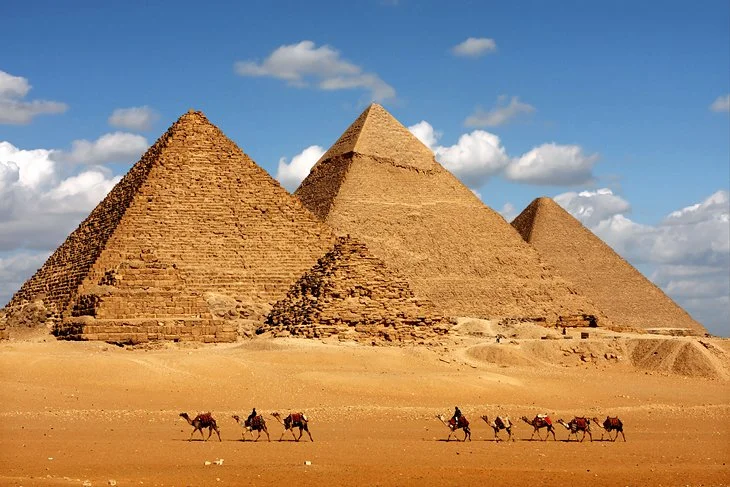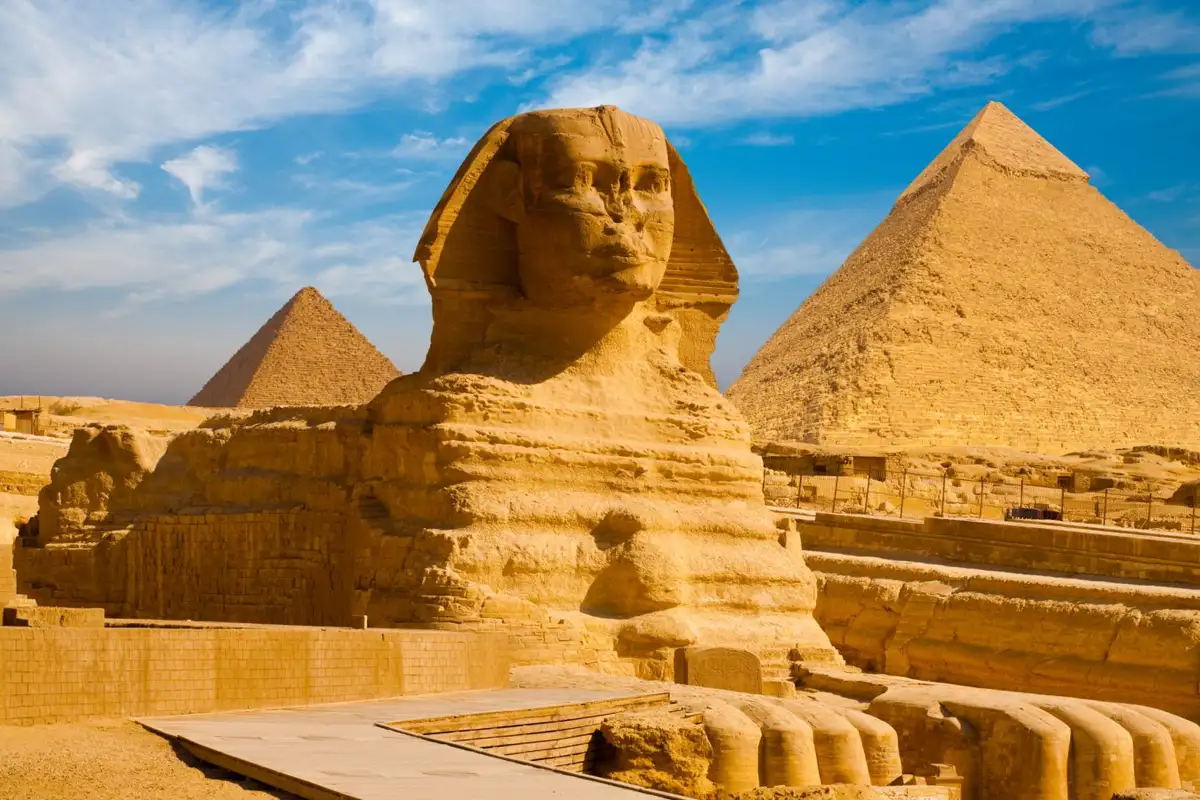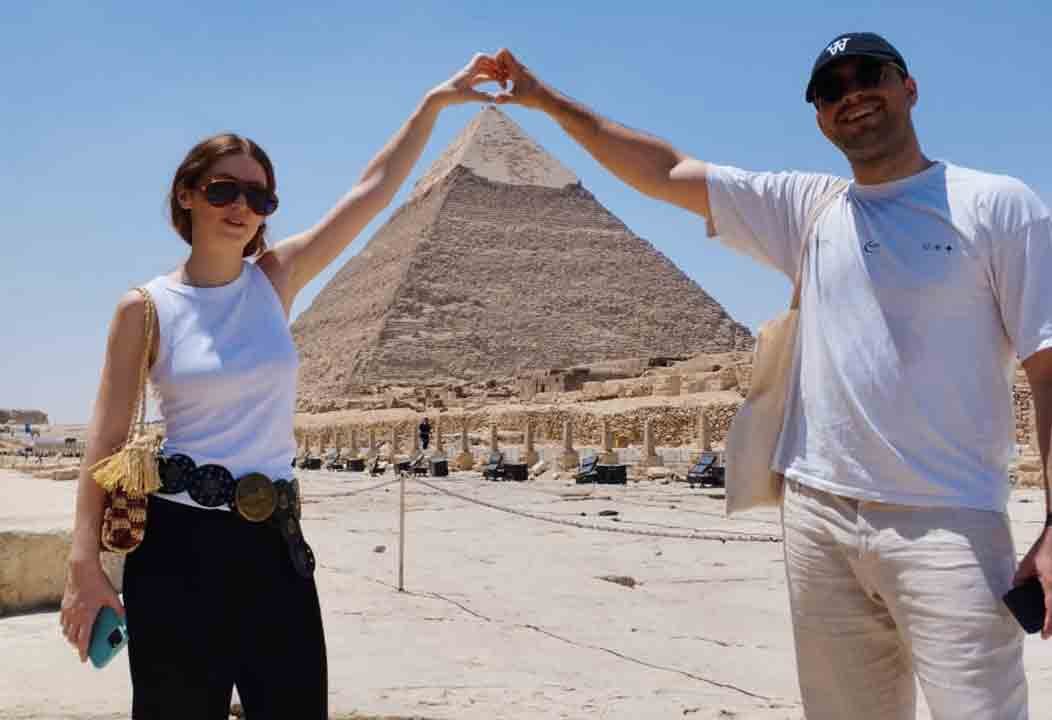The Giza Pyramid Complex and Great Sphinx, situated near Cairo, Egypt, are remarkable ancient structures that have fascinated people for centuries. Built around 2580–2560 BCE during the Fourth Dynasty, the complex includes the Great Pyramid of Khufu, the Pyramid of Khafre, and the Pyramid of Menkaure. These colossal pyramids showcase the incredible architectural skills of the ancient Egyptians.
Adjacent to the pyramids is the mysterious Great Sphinx of Giza, a massive statue with the body of a lion and the face of a pharaoh, thought to represent Khafre. The Giza Pyramid Complex remains a captivating symbol of ancient ingenuity and continues to attract global interest. Explore these enduring wonders that stand as a testament to the grandeur of an ancient civilization.
The Giza Pyramid Complex
The Giza Pyramid Complex is a famous ancient site near Cairo, Egypt. It includes the Great Pyramid, one of the Seven Wonders of the Ancient World. Built over 4,500 years ago, the complex has three main pyramids like Khufu, Khafre, and Menkaure.

The Great Pyramid Complex of Khufu
Khufu’s pyramid complex, anchored by the Great Pyramid, serves as a dual marvel of ancient engineering and spiritual significance. The valley temple, hidden beneath the modern village of Nazlet el-Samman, remains a tantalizing mystery, while the Mortuary Temple of Khufu, connected by a causeway, reveals glimpses of the grand rituals associated with ancient burials.
Constructed between 2580 – 2560 BC, the Great Pyramid boasts three smaller queen’s pyramids and three boat pits. The meticulously restored Khufu ship within one of these pits stands as a testament to the advanced maritime knowledge of the ancient Egyptians. While the original casing stones crafted from fine white limestone have dwindled, Khufu’s Pyramid remains an enduring symbol of ancient ingenuity.
Khafre’s Pyramid Complex
Situated a few hundred meters southwest of the Great Pyramid, Khafre’s pyramid complex unveils a majestic arrangement of structures. The valley temple, Sphinx temple, causeway, mortuary temple, and the king’s pyramid collectively contribute to an awe-inspiring ensemble. The Sphinx, believed to depict Khafre, stands as the guardian of this complex, exuding a sense of regality and divine authority.
Despite Khafre’s Pyramid appearing smaller than Khufu’s, its elevated location and steeper construction angle give it a larger appearance. The retaining display of casing stones at its apex preserves an aesthetic legacy, showcasing the Egyptians’ commitment to blending architectural precision with symbolic significance.
Menkaure’s Pyramid Complex
Completed around 2510 BC, Menkaure’s pyramid complex provides a unique insight into the royal legacy of ancient Egypt. The valley temple, causeway, mortuary temple, and the king’s pyramid compose a harmonious setting. An ante-temple added during the 5th Dynasty underlines the complex’s evolving significance, hinting at the cultural and architectural diversity embedded in the Giza plateau.
Among the four major monuments of Giza, only Menkaure’s pyramid stands today without its original polished limestone casing. Despite the absence of this external layer, the complex stands as a poignant reminder of the cultural and architectural diversity embedded in the Giza plateau.
The Sphinx
The Great Sphinx of Giza is a huge statue in Egypt that looks like a mix of a person and a lion. It was made a really long time ago, around 4,500 years ago, during the time of an ancient Egyptian ruler named Pharaoh Khafre. The statue is massive, about 73 meters long, 20 meters tall, and 19 meters wide. It’s famous for facing from west to east.
There’s a mystery about its missing nose – some people used to think it got broken during a war, but it turns out that happened way before, and no one is sure exactly how. Despite its age, the Sphinx continues to be a symbol of ancient Egypt’s skill and creativity, inviting people to explore its history and secrets.

In Greek, the term “sphinx” carries a dual meaning, suggesting both “strangler” and “constricted,” as highlighted by Carolina Lopez Ruiz, a classics professor at The Ohio State University. This intriguing insight adds a layer of mystique to the iconic Great Sphinx of Giza. Explore also The Temple of Hatshepsut.
What Purpose Did The Pyramids have?
The main idea was that the pyramid acted as a kind of permanent home for the pharaoh after they died. It was meant to be super strong and last forever. Next to the pyramids, there were temple buildings dedicated to worshiping the deceased pharaoh, with the belief that this worship would continue forever.
In simpler terms, the pyramids were like eternal houses for the pharaohs, and the temples nearby were places for people to remember and honor them.
Conclusion
Giza Pyramid Complex and the Great Sphinx of Egypt stand as incredible testaments to the ancient Egyptians’ architectural prowess and spiritual beliefs. Khufu’s Great Pyramid, Khafre’s majestic complex, Menkaure’s legacy, and the mysterious Sphinx all contribute to the awe-inspiring ensemble on the Giza plateau. Despite the passage of over 4,500 years, these structures continue to captivate the world, symbolizing the grandeur of an ancient civilization. The purpose of the pyramids was to serve as eternal homes for the pharaohs, with nearby temples dedicated to perpetual worship and remembrance. The enduring legacy of these structures invites us to explore the rich history and secrets of ancient Egypt.

